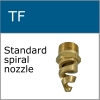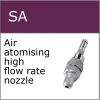Nozzles for pre-quench of hot gasses
An important part of the removal of pollutants from hot flue gasses can be the cooling of the gas prior to contact with the reacting (scrubbing fluid). If the gas is too hot when it enters the scrubbing chamber proper then the reacting fluid may evaporate too quickly before it can react with the target pollutants. So whilst quenching itself does not remove pollutants it is included here as a key pollution control application as it is often vital to the gas scrubbing process.
Cooling gasses
Often flue gasses are moving at high velocities and so the transit time from the point of the quench spray to the entry into the scrubber proper can be very short. As the quench process relies on the large amounts of energy involved in the phase transition from water to steam, it is vital that as much of the quench fluid can be evaporated in as short a time as possible. The key to this is ensuring that the quench spray consists of small droplet sizes and that the spray is evenly distributed across the whole gas flow.
Often this process is optimised by simply opting for the nozzles that can deliver the required flow rate with a spray consisting of the smallest possible droplet sizes. However, as the diagram below shows in certain situations heavier droplets may be required to carry the spray into the gas flow.

Nozzle selection
The TF spiral range of nozzles delivers sprays which have many excellent properties for quench applications. The average droplet sizes are smaller than other styles of nozzle for any given pressure and flow rate meaning faster evaporation rates. Further to this the spiral nozzle has some bands of heavier droplets which help to carry the whole spray through fast moving gas flows giving better coverage than other nozzle types.

The spiral air nozzle is a high flow rate air atomising nozzle which delivers good volumes of fluid with very fine droplet sizes. This makes it a suitable choice for pre-quench applications
